MRI in Alzheimer's Disease
Oral
Neuro
Wednesday, 20 June 2018
| S05 |
08:15 - 10:15 |
Moderators: Qiyong Gong, Mark Meadowcroft |
08:15
|
0723.
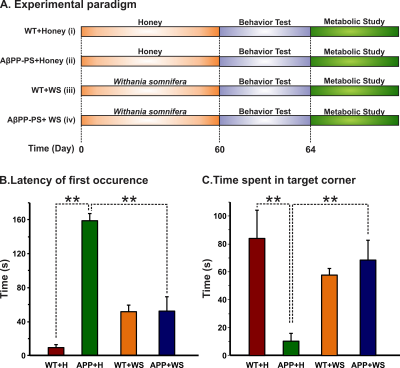 |
 Reversal of Behavioral and Metabolic Deficit with Withania Somnifera in Alzheimer's Disease Mice: A 1H-[13C]-NMR Study Reversal of Behavioral and Metabolic Deficit with Withania Somnifera in Alzheimer's Disease Mice: A 1H-[13C]-NMR Study
Kamal Saba, Nunna Haritha, Anant Patel
Alzheimer’s disease (AD) is a degenerative disorder and the most common cause of dementia. The hallmark of AD is the accumulation of Aβ-plaque in the subject brain. At present there is no treatment for AD. Extracts of Withania somnifera (WS) roots has been shown to promote neurite outgrowth and improve learning and memory in AD mice. The current study examine the effects of WS on neurometabolism in AβPP-PS1 mouse model of AD by using 1H-[13C]-NMR spectroscopy in conjunction with infusion of [1,6-13C2]glucose. Our findings indicate that WS improved learning and memory, and ameliorate the neurometabolism in AβPPPS1 mice.
|
08:27
 |
0724.
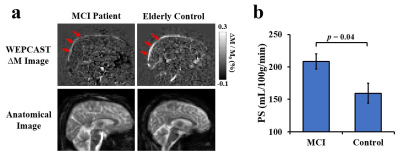 |
 Imaging disruption of blood-brain-barrier (BBB) in Mild Cognitive Impairment without using contrast agent Imaging disruption of blood-brain-barrier (BBB) in Mild Cognitive Impairment without using contrast agent
Zixuan Lin, Sandeepa Sur, Peiying Liu, Jill De Vis, Yang Li, Pan Su, Jay Pillai, Sevil Yasar, Paul Rosenberg, Marilyn Albert, Abhay Moghekar, Hanzhang Lu
Disruption of BBB in AD has received increasing attention due to its potential role in amyloid accumulation and clearance. However, measurement of BBB leakage in AD has been proven challenging, especially when using non-contrast techniques. In this study, we measured BBB permeability to water in MCI patients using a novel technique that does not require any contrast agent. It was found that MCI patients have a higher permeability-surface-area-product (PS), i.e. leaky BBB, compared to elderly controls. Individuals with higher PS values had poorer cognitive performance and more severe vascular inflammation. These findings support the role of BBB disruption in AD.
|
08:39
 |
0725.
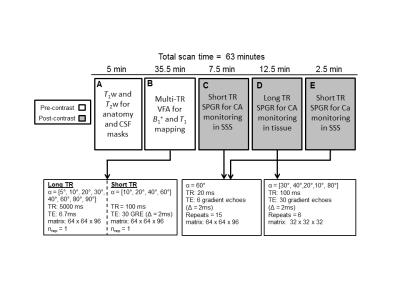 |
 Increased BBB leakage to water but not gadolinium in a rat model of Alzheimer’s disease Increased BBB leakage to water but not gadolinium in a rat model of Alzheimer’s disease
Ben Dickie, José Ulloa, Hervé Boutin, Laura Parkes, Geoff Parker
The presence of blood-brain barrier (BBB) dysfunction in patients with Alzheimer’s disease (AD) is unclear. This study uses a novel MRI approach to study AD and age-related alterations in BBB leakage to water (PSw) and gadolinium (Ktrans) in a transgenic rat model of AD. We show PSw is increased in transgenic animals relative to wild-types but that Ktrans is independent of genotype. This study demonstrates the benefit of probing the BBB with molecules of different sizes, and suggests measurements of BBB permeability to water are more sensitive to AD-related BBB alterations than estimates of gadolinium leakage.
|
08:51
|
0726.
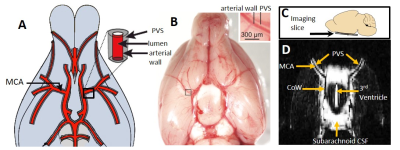 |
 Non-invasive Assessment of Glymphatic Inflow: Measurement of Perivascular Fluid Movement using Diffusion Tensor MRI Non-invasive Assessment of Glymphatic Inflow: Measurement of Perivascular Fluid Movement using Diffusion Tensor MRI
Jack Wells, Ian Harrison , Bernard Siow, Aisha Akilo, Phoebe Evans, Ozama Ismail, Yolanda Ohene, Payam Nahavandi, David Thomas, Mark Lythgoe
The glymphatic system may play a critical role in the parenchymal clearance of amyloid beta, a leading molecular candidate to initiate Alzheimer’s disease. Clinical investigation, however, is currently hindered by an absence of non-invasive techniques for assessment. The movement of fluid in the perivascular space represents a central component of the glymphatic pathway. Here, we present the first non-invasive evaluation of glymphatic function by using an ultra-long echo-time, low b-value, diffusion-tensor sequence targeted to the perivascular space of the rat brain. We demonstrate that this novel technique is sensitive to the fluid movement along perivascular channels that drives glymphatic inflow.
|
09:03
|
0727.
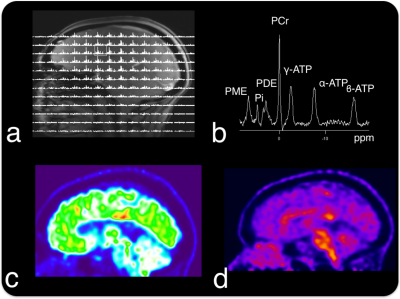 |
 Multinuclear MR and PET for Studying Energetic Adaptations in Individuals at Increased Risk for Alzheimer’s Disease Multinuclear MR and PET for Studying Energetic Adaptations in Individuals at Increased Risk for Alzheimer’s Disease
Prodromos Parasoglou, Lisa Mosconi, Oleksandr Khegai, Margo Miller, Seena Dehkharghani, Antonio Convit, Ricardo Osorio, Ryan Brown
31P-MRS directly assesses metabolites linked to cellular metabolism, which may be altered at the early stages of Alzheimer’s disease (AD). A major challenge for 31P-MRS is the low sensitivity of the 31P nucleus. Therefore, 31P-MRS has only been used sporadically in AD research. To address this, we built a highly-sensitive dual-nuclei (31P/1H) radio frequency coil array and acquired whole-brain 31P-MRS data from cognitive normal subjects at increased risk for AD, who had previously received FDG and amyloid-PET evaluations. Our goal was to detect energetic abnormalities in this pre-clinical population and compare 31P-MRS findings with established PET-based biomarkers of AD.
|
09:15
|
0728.
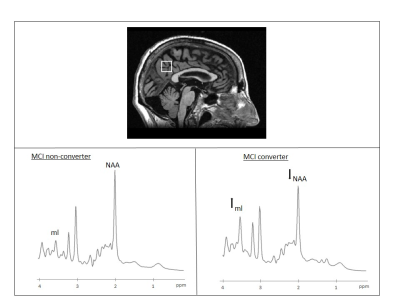 |
 Brain 1H-MRS and volumetric changes predict conversion from Mild Cognitive Impairment to Alzheimer’s disease: a follow-up study Brain 1H-MRS and volumetric changes predict conversion from Mild Cognitive Impairment to Alzheimer’s disease: a follow-up study
Micaela Mitolo, Michelangelo Stanzani-Maserati, Stefania Evangelisti, Lia Talozzi, Federico Oppi, Roberto Poda, Claudio Bianchini, Lorenzo Cirignotta, Luisa Sambati, David Manners, Claudia Testa, Sabina Capellari, Roberto Gallassi, Rocco Liguori, Raffaele Lodi, Caterina Tonon
Predicting the possible evolution from the prodromal MCI stage to dementia is a great challenge for both clinic practice and research. We investigated the predictive role of magnetic resonance spectroscopy and brain volumetry in the progression from Mild Cognitive Impairment (MCI) to Alzheimer’s Disease (AD). The (NAA+NAAG)/ml ratio in the Posterior Cingulate Cortex (PCC) discriminates at baseline MCI converters from non-converters with an accuracy of 79% after a mean follow-up of 28 months. Volumetric reduction of the parahippocampal gyrus and fusiform gyrus was also found to be an accurate marker of progression to AD (Accuracy 84.2% and 73.6% respectively).
|
09:27
 |
0729.
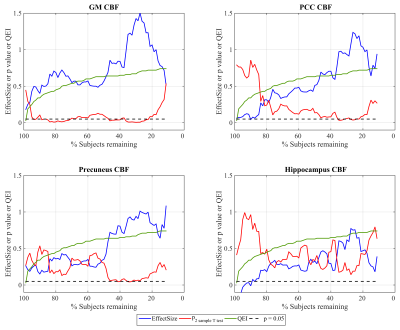 |
 Elevated cerebral blood flow in amyloid-positive elderly cognitively normal controls Elevated cerebral blood flow in amyloid-positive elderly cognitively normal controls
Sudipto Dolui, Zhengjun Li, Duygu Tosun, Michael Weiner, David Wolk, John Detre
We evaluated the effects of [18F]-Florbetapir PET-derived amyloid (A$$$\beta$$$) status on regional cerebral blood flow (CBF) measured using pulsed arterial spin labeling (PASL) in control subjects from the Alzheimer’s Disease Neuroimaging Initiative (ADNI) database. Mean CBF in whole grey matter, posterior cingulate and precuneus showed significantly higher CBF in amyloid positive (A$$$\beta$$$+) group compared to the amyloid negative (A$$$\beta$$$-) group after eliminating subjects with poor PASL data quality as assessed by an automated algorithm. Subjects with higher CBF in the A$$$\beta$$$- group also demonstrated better episodic memory whereas a reverse trend was observed in the A$$$\beta$$$+ group.
|
09:39
|
0730.
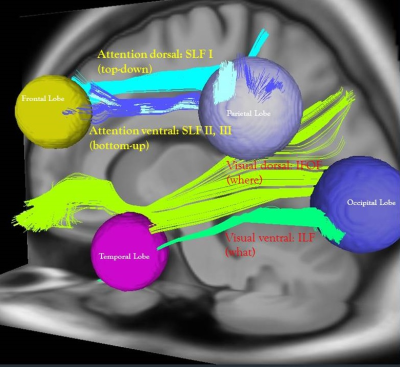 |
 Intrinsic Visual Attention Networks and Their Structural Connectivity Reveal Structure-Function Changes of the Visual-Attention System in Subjective Cognitive Decline and Mild Cognitive Impairment Intrinsic Visual Attention Networks and Their Structural Connectivity Reveal Structure-Function Changes of the Visual-Attention System in Subjective Cognitive Decline and Mild Cognitive Impairment
Pin-Yu Chen, Yung-Chin Hsu, Chang-Le Chen, Yu-Ling Chang, Ming-Jang Chiu, Wen-Yih Tseng
In addition to the memory problems, older adults with mild cognitive impairment (MCI) may suffer from visual-attention problems. We speculated that even at the very early stage such as subjective cognitive decline (SCD), visual-attention function may be affected. We investigated the control, SCD and MCI groups’ functional connectivity of the attention and visual networks and the five association fiber tracts responsible for long-range dorsal and ventral pathways. The ventral attention and ventral visual networks exhibit significant group differences in all functional, structural connectivity and cortical thickness. Our findings suggest that in contrast to the top-down goal-directed dorsal attention and the object location of dorsal visual functions, the ventral attention and ventral visual functions for processing unfamiliar stimuli and object recognition may be changed in SCD and MCI. In summary, the visual-attention functions may be affected in SCD and MCI.
|
09:51
|
0731.
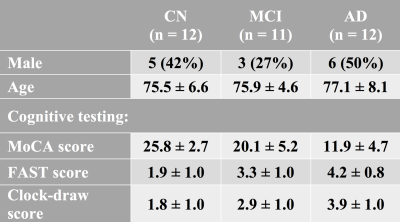 |
 Development of advanced multiparametric MRI biomarkers of Alzheimer’s disease Development of advanced multiparametric MRI biomarkers of Alzheimer’s disease
Ashley Stokes, Zhiqiang Li, James Pipe, Richard Caselli, Marwan Sabbagh, Leslie Baxter
The goal of this project is to establish advanced MRI signatures of each stage of Alzheimer’s disease (AD), including preclinical, mild cognitive impairment (MCI), and dementia stages. These advanced imaging methods will allow us to non-invasively investigate the underlying neurobiological changes that precede cognitive impairment. While structural MRI is known to change with disease progression, advanced MR imaging may provide more specific signatures of disease progression. The asymptomatic and MCI phases represent a clear potential for early intervention, and the non-invasive methods developed here may identify patients along the clinical trajectory of AD.
|
10:03
|
0732.
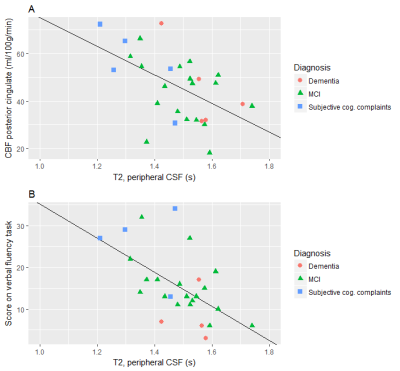 |
 Lower oxygenation in the peripheral subarachnoid space reflects decreased cerebral blood flow in dementia-related brain structures Lower oxygenation in the peripheral subarachnoid space reflects decreased cerebral blood flow in dementia-related brain structures
Lisa van der Kleij, Ilse Kant, Geert Jan Biessels, Jeroen Hendrikse, Esben Petersen, Jill De Vis
We evaluated the relationship between cerebral blood flow (CBF) and T2 of peripheral CSF. The rationale behind this hypothesized association is the presumed dependency of T2 on oxygenation. The T2 of CSF was related to CBF and cognition in a group with cognitive decline. In contrast, no relationship was found between the T2 and CBF in a healthy aging cohort suggesting no relation between the T2 of CSF and oxygenation. Further investigation regarding the relation between T2 of CSF and cognition in the healthy aging cohort are ongoing and could shed light on the value of T2 as a biomarker.
|
|













